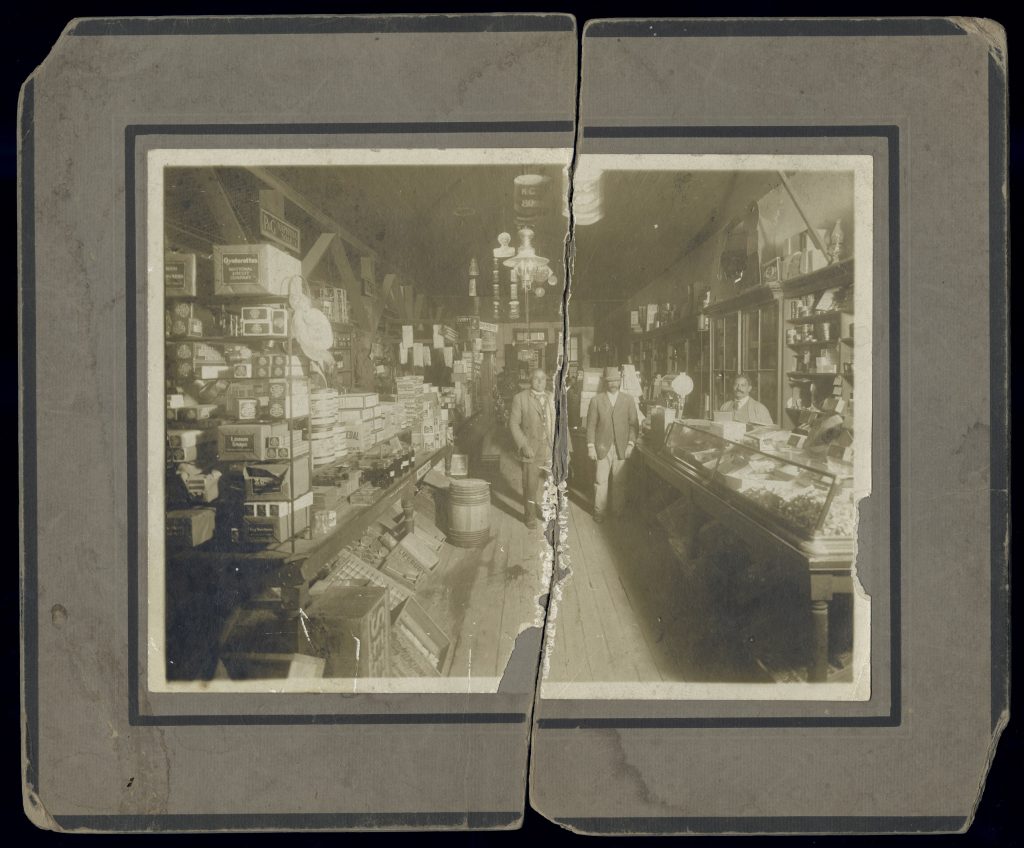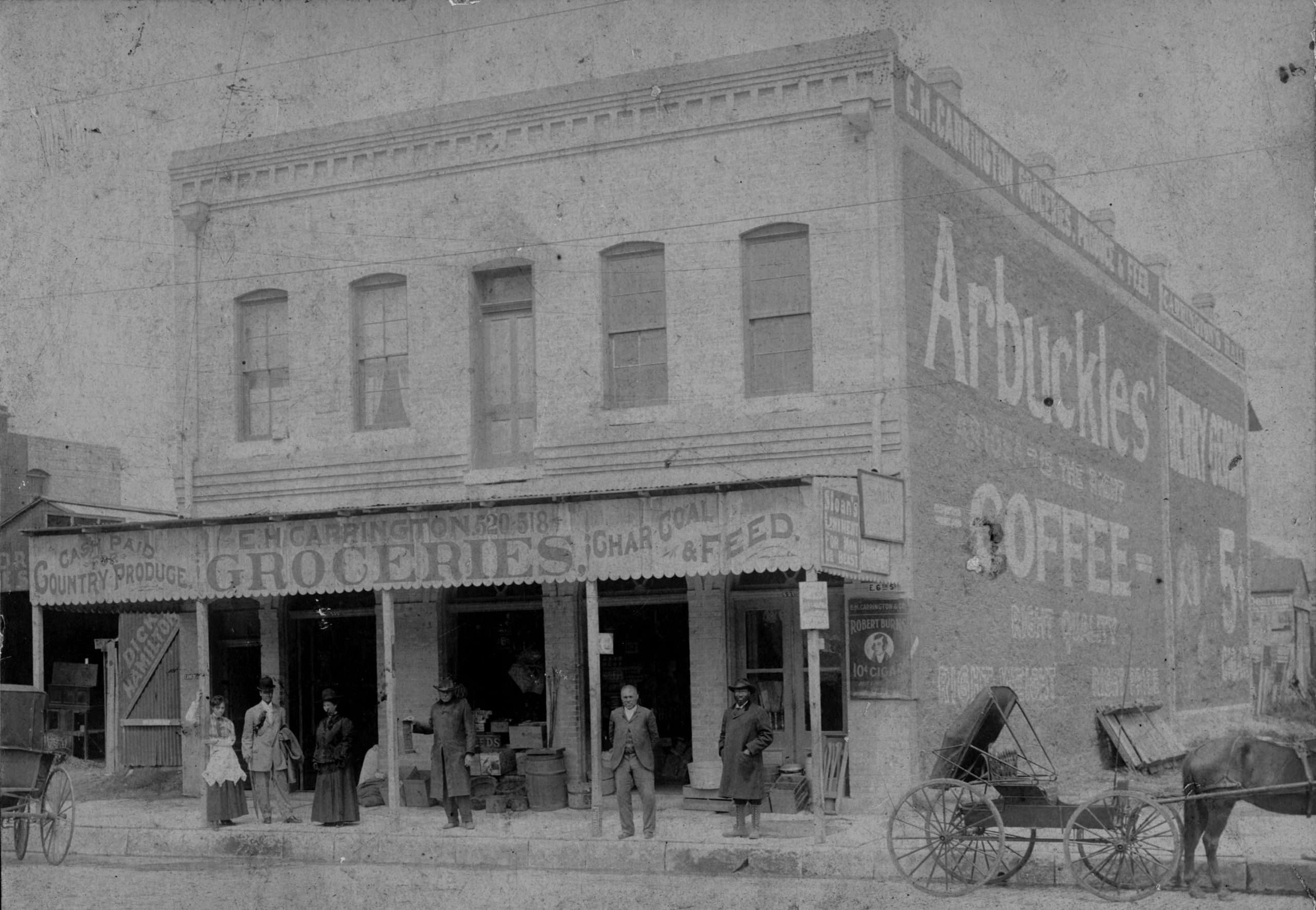Curriculum Connections: African American History, Reconstruction, Westward Expansion
The sources in this lesson come from the Prescott Family Papers.
Download a copy of this lesson plan or a copy of the source images and transcripts in the Downloads tab.
This lesson can help students develop visual literacy within a history curriculum and develop both close examination skills and research skills.
Process
You and your students will examine two photographs found in the Prescott Collection at the Newberry Library. You will encourage students to get as much information as they can from each image and both images together about the store, the Carrington and Lyons families, and the racial situation in Austin in the early twentieth century. You will use a two-step process. First, identify questions the photographs might answer. Second, try to answer the questions. You might want to review the Skills Lesson: Dating a Photograph.
After you have looked at both photographs, you will read the short excerpt from the Lavinia Prescott Ferguson oral history, which offers a glimpse of life for African Americans in Austin in the early twentieth century.
Source 1—Carrington Store Exterior

Show students the high-resolution version of the first photograph. While looking at the photograph, which shows the outside of the Carrington store, explain that a photograph can be a source of historical information. Depending on your grade level and any experience your students may have in examining primary sources, you may encourage students to come up with questions themselves that they think they can answer by examining the source, or you may decide to challenge students to answer questions you pose.
For more advanced students, provide no additional background information at first, letting them figure out everything they can on their own. For younger students, provide whatever background you think will help them, but try not to give them information they can figure out relatively easily on their own.
This can be a whole-class activity, or you can divide the class into groups. The latter may give more students the opportunity for active participation. If you have students that thrive on competition, you can make it a contest. Each group can come up with questions for the other group to answer. (The questions must be ones they can answer themselves.) The following are some questions your students might generate. You can use them to model the process for your students. You can also ask students these questions yourself if, in your judgment, the students need more help.
Ask Questions
What questions can you answer using this image?
- What is the name of the person who owns this store?
- What are some things the store sells?
- What is the store built of?
- How big is the store?
- What can you tell about the people standing in front of the store?
- What clues do you have about when the photograph was taken?
(Research into the products advertised in the image could yield these results about the potential date: Arbuckles’ Coffee, no earlier than 1868. Sloan’s Liniment for Man or Beast, no earlier than 1871. Pet Milk, no earlier than 1895).
Then ask students to give you questions they could not answer about the Carrington store by looking at the photograph.
What questions can’t you answer with this photograph?
- What was the exact year the picture was taken?
- Where is the store?
- What are the names of the people in front of the store?
- What do the people have to do with the store?
- What is inside the store?
Source 2—Carrington Store Interior

When you show students this second photograph, ask them to come up with questions they might be able to answer using the information they can get from this image and the first image put together. Then ask them to give you questions they could still not answer about the store, the family, and life in Austin by looking at both images.
Ask Questions
What new questions can you answer with this photograph?
- Is there a person who is pictured in both photographs? Which one? Who do you think he is?
- What does the inside of the store look like?
- What different kinds of products does the store sell?
- Is this the whole inside of the store? Why do you think it is or isn’t?
- What clues do you have about the year the picture was taken?
(Research into the products advertised in the store might yield these results about the potential date: P&G Naptha, after 1902; Old Dutch Cleanser, after 1906; Nabisco logo, between 1900 and 1918; The Quaker Oats box is square. The Quaker box changed to round in 1915, so before 1915.)
What questions can’t you answer with this photograph?
- What was the exact year the picture was taken?
- What were the people in the photographs like?
- How was this Black family treated by the white residents of Austin?
Source 3—Excerpt from Lavinia Prescott Ferguson Oral History
Lavinia Prescott Ferguson was the daughter of Eunice Lyons and James Connor Prescott. Eunice Lyons was the daughter of L. D. Lyons, who took over the Carrington store from E. H. Carrington.
My mother was just about five years old, and she was in the store. She always liked to help her father in the store. She was very much on the same track as he was and she liked to sell little things or hand them out to the customers. She was in the store that day and a colored fellow ran through the store and my grandfather told him where to go.
Shortly afterwards, some white men came through and they said, ‘Colonel!’
They called my grandfather Colonel, Colonel L.D. Lyons. They said, ‘Colonel!’ This was their expression and I don’t like to always use these words, but this is how the story is told: ‘Colonel, did you just see a n_____ run through here?. . . Did you just see him?’
And, my grandfather said to them, ‘Yes, I saw him, he went that way!’
But what my grandfather had done, he had this big pickle barrel, and he opened the pickle barrel and put this man in there. He put the lid on, and he took my mother, whom I said was about five years old, sat her on top of the pickle barrel and he told her at the time, he said, ‘Don’t move, don’t get off!’
And she didn’t. She sat just like this. These men that was looking for him, said ‘Thank you Colonel! Now we know which way to go.’ They went out that way looking for him.
Later that evening, my grandfather got a wagon full of hay and put this man at the bottom of the wagon under the hay and had my mother and one or two of the other children–like they were going for a hayride. They were able to get him to the train and get him up to Chicago.
Lavinia Prescott Ferguson
Ask Questions
What questions can you answer from this story that you couldn’t answer from the photographs?
- How is the girl in the store related to the Lavinia Ferguson?
- How did Lavinia Ferguson know about this event?
- Why was the man running?
- Why did he come to the store?
- What do you think the group of white men planned to do the man they were chasing?
- How did the white men treat L. D. Lyons?
- What does the incident tell you about L. D. Lyons? About the little girl?
Background
These photographs were found among the papers of Lavinia Prescott Ferguson. On the back of the interior photograph, her mother, Eunice Prescott, had written “Daddy, Grandpapa and Uncle Albert.” The family lived in Austin, Texas, and the three men have been identified as, left to right, E. H. Carrington, his brother Albert Carrington, and E. H. Carrington’s son-in-law, L. D. Lyons. Both of the Carrington men were first seen in the voting roles of Austin in 1867, during Reconstruction.
The text is an excerpt from an oral history given by Lavinia Prescott Ferguson in Chicago in the early 2000s.
By 1872 Edward Holmes Carrington was running a grocery store on a major mercantile street in Austin: Pecan, later Sixth, Street. The store was taken over by L. D. Lyons in about 1912, but E. H. continued to be involved in the running of the store. His brother Albert was a blacksmith and worked out of the yard in the back of the store. In fact, a horse can be seen out the back door of the store in the second photograph, and the man we have identified as Albert is wearing heavy gloves. Albert Carrington was an alderman from 1883 until 1885. Although he announced that he would run again in 1885, anecdotal evidence suggests that he was “told” to stop his campaign. He was Austin’s last Black alderman until the 1970s.
Extension Activities
Encourage your students to develop close examination and research skills, and increase their sense of how history is discovered, by giving them additional photographs to date. You can do a search for photographs in the Newberry’s Digital Collections or on the Library of Congress website, Prints and Photographs Division.
Words to Know
oral history │ an interview with someone who has personal knowledge of the past
Additional Resources
“African Americans in Austin,” You Are Here at ATX.
Barr, Alwyn. Black Texans: A History of African Americans in Texas, 1528-1995. Newberry Library Special Collections – Edward E. Ayer Collection – 4th floor; Ayer E185.93.T4 B37 1996.
Mears, Michelle M. And Grace Will Lead Me Home: African American Freedmen Communities of Austin, Texas, 1865-1928. Newberry Library General Collection 2nd Floor (F394.A99 N4 2009).
Download copies of the lesson plan and the sources below.



